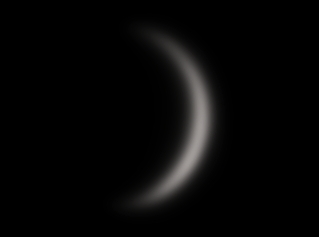
Venus, IC410, IC405, Zodiacal Light, Horsehead Nebula
Posted: 27 December 2013
|
Opened: Thursday, 26 December 2013, 1807 MST Temperature: 53°F |
Session: 633 Conditions: Clear, breezes |
Viewed Venus with the 8" LX200-ACF, 83X, at 1816 MST. Lovely crescent. Seeing was not ideal for viewing and imaging. Switched to a 1.25" 9mm eyepiece with #21 Orange Filter + a Moon Filter. Added the 2" 2X PowerMate, yielding 444X. The filters and higher magnification provided a better view, but Venus was difficult to focus due to the seeing conditions.
Mounted the iPhone 5s using my homemade iPhone afocal adapter and did two slo-mo video recordings (120 fps) with the earbuds being used as a remote shutter release. Stacked 1716 video frames using Keith's Image Stacker on the Macintosh. Desaturated the resulting stacked image with this result:

At 1835 MST, viewed IC410 (diffuse nebula) and then IC405 (diffuse nebula), 83X. Both were very faint and difficult to see. Added a focal reducer and mounted the D7000 DSLR using the off-axis guider. Did a focus test image on Capella using the Bahtinov Mask. Went back to IC410 and found a faint guide star and did a framing test exposure. The nebula was not visible on the camera viewscreen with the 1 minute, ISO 6400, exposure. Decided I would image it anyway. This is a highly edited, slightly cropped, guided, 5 minute, ISO 6400, image that shows some nebulosity:

Slewed to IC405, found a guide star, and did a guided, 5 minute, ISO 6400, exposure. This image, also highly edited and slightly cropped, shows some good nebulosity:

I plan to re-image both IC410 and IC405 on a future session using multiple exposures for stacking.
At 1927 MST, the Zodiacal Light was visible in the western sky. Put the telescope to sleep and set up the D7000 DSLR on a photographic tripod. I used an 8mm fisheye lens for this f/5, 30 second, ISO 5000, photograph taken at 1948 MST:

Mouseover or tap the image to see labels
You can see the Zodiacal Light almost to the meridian. M31 was near the zenith (top) at the time of the photograph.
I returned to the observatory, woke the telescope, and at 2005 MST, slewed to the star Rigel in the constellation of Orion and began preparing to image the Horsehead Nebula (IC434) at prime focus of the 8" telescope. Did a focus test on Rigel with the Mask, then slewed to the Horsehead Nebula and did two framing test exposures while searching for a guide star. Found a good star. Beginning at 2032 MST, I did 12 5-minute, ISO 6400, guided exposures. After every 4th exposure I took a short break to stretch and drink some hot chocolate. Seeing was not perfect and the guide star frequently blurred. The breezes didn't help. I ended imaging at 2139 MST. During post-processing I cropped and stacked the 12 images using Lynkeos on the Macintosh. This is the result with an effective exposure time of one hour:

This is my best Horsehead image to date.
I removed the camera and at 2154 MST, viewed NGC2237 (Rosette Nebula), 83X. It was faintly visible. I'll image it on a future session. Then viewed Jupiter, 83X and 166X. The four Galilean Moons were visible.
|
Closed: Thursday, 26 December 2013, 2208 MST Temperature: 48°F |
|
Comments are welcome using Email. Thanks.
Cassiopeia Observatory Home Page